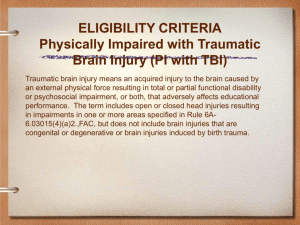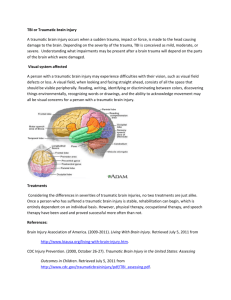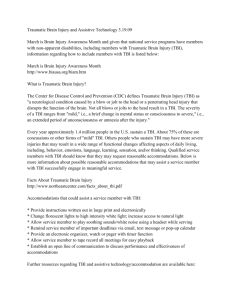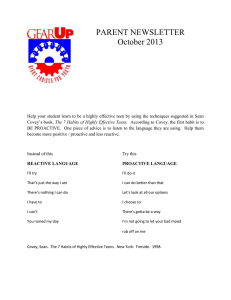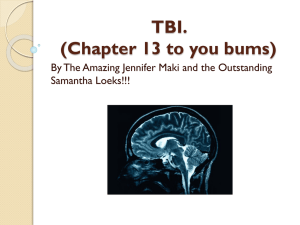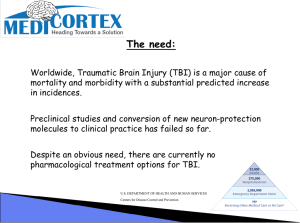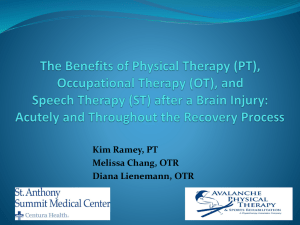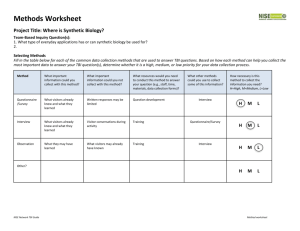S
advertisement
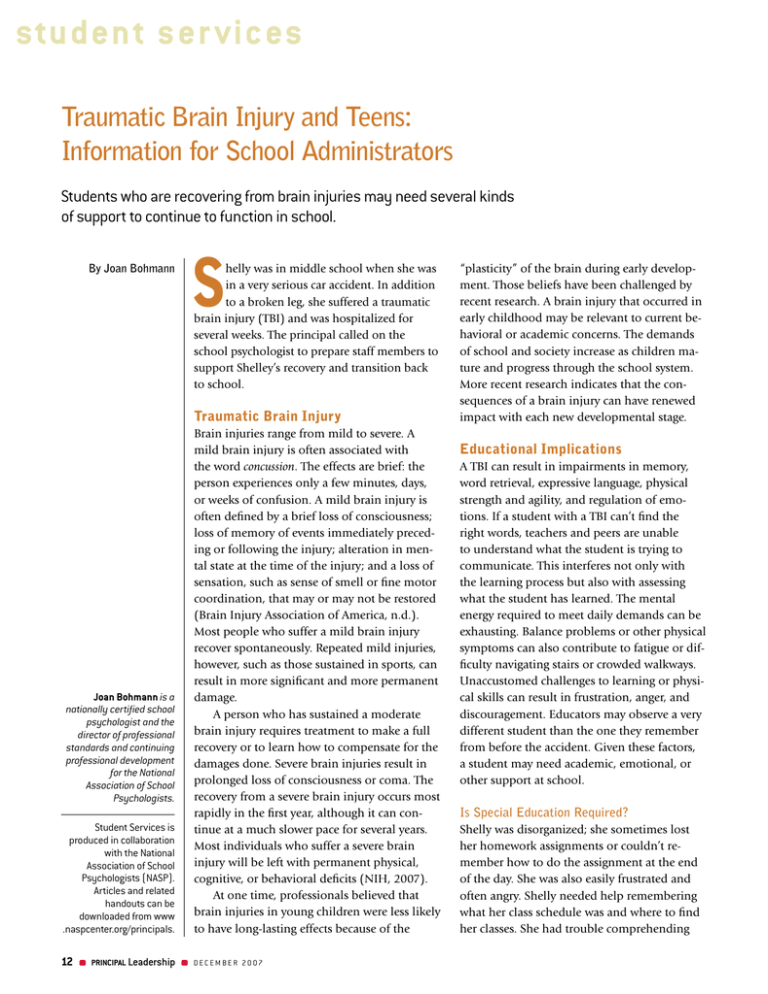
student ser vices Traumatic Brain Injury and Teens: Information for School Administrators Students who are recovering from brain injuries may need several kinds of support to continue to function in school. By Joan Bohmann S helly was in middle school when she was in a very serious car accident. In addition to a broken leg, she suffered a traumatic brain injury (TBI) and was hospitalized for several weeks. The principal called on the school psychologist to prepare staff members to support Shelley’s recovery and transition back to school. Traumatic Brain Injury Student Services is produced in collaboration with the National Association of School Psychologists (NASP). Articles and related handouts can be downloaded from www .naspcenter.org/principals. Brain injuries range from mild to severe. A mild brain injury is often associated with the word concussion. The effects are brief: the person experiences only a few minutes, days, or weeks of confusion. A mild brain injury is often defined by a brief loss of consciousness; loss of memory of events immediately preceding or following the injury; alteration in mental state at the time of the injury; and a loss of sensation, such as sense of smell or fine motor coordination, that may or may not be restored (Brain Injury Association of America, n.d.). Most people who suffer a mild brain injury recover spontaneously. Repeated mild injuries, however, such as those sustained in sports, can result in more significant and more permanent damage. A person who has sustained a moderate brain injury requires treatment to make a full recovery or to learn how to compensate for the damages done. Severe brain injuries result in prolonged loss of consciousness or coma. The recovery from a severe brain injury occurs most rapidly in the first year, although it can continue at a much slower pace for several years. Most individuals who suffer a severe brain injury will be left with permanent physical, cognitive, or behavioral deficits (NIH, 2007). At one time, professionals believed that brain injuries in young children were less likely to have long-lasting effects because of the 12 dec e m be r 20 07 Joan Bohmann is a nationally certified school psychologist and the director of professional standards and continuing professional development for the National Association of School Psychologists. Principal Leadership “plasticity” of the brain during early development. Those beliefs have been challenged by recent research. A brain injury that occurred in early childhood may be relevant to current behavioral or academic concerns. The demands of school and society increase as children mature and progress through the school system. More recent research indicates that the consequences of a brain injury can have renewed impact with each new developmental stage. Educational Implications A TBI can result in impairments in memory, word retrieval, expressive language, physical strength and agility, and regulation of emotions. If a student with a TBI can’t find the right words, teachers and peers are unable to understand what the student is trying to communicate. This interferes not only with the learning process but also with assessing what the student has learned. The mental energy required to meet daily demands can be exhausting. Balance problems or other physical symptoms can also contribute to fatigue or difficulty navigating stairs or crowded walkways. Unaccustomed challenges to learning or physical skills can result in frustration, anger, and discouragement. Educators may observe a very different student than the one they remember from before the accident. Given these factors, a student may need academic, emotional, or other support at school. Is Special Education Required? Shelly was disorganized; she sometimes lost her homework assignments or couldn’t remember how to do the assignment at the end of the day. She was also easily frustrated and often angry. Shelly needed help remembering what her class schedule was and where to find her classes. She had trouble comprehending textbooks at her grade level. Her grades fell. She qualified for special education services for part of her day and also needed help navigating her day and courses. Students who have experienced a TBI may be eligible for special education or Section 504 services. Two key points in the federal definition of TBI are that the injury must have occurred as a result of external force and that the results of the injury must adversely affect the student’s educational performance. Events that cause brain damage but do not fall under the federal definition of TBI include brain tumors, lack of oxygen, and stroke. Also, a student who experiences a complete recovery from a brain injury or who has only mild residual effects, such as occasional headaches, may be able to navigate the school and pass his or her classes. Such a student would not meet the requirement for impairment in educational ­functioning. Eligibility for a 504 plan requires that the TBI causes a substantial limitation in the student’s ability to learn or perform another major life activity, such as walking, seeing, talking, or hearing. A 504 plan might be necessary for students who do not require special education but who nevertheless have substantial academic needs, such as a student who understands the concepts being taught but cannot keep up with the note-taking demands of a classroom, which results in poor performance on tests and assignments. The accommodation plan might allow the student to tape lectures, have a scribe in the classroom, or copy the teacher’s lecture notes. For a student who fatigues easily, the accommodation plan might allow the student to complete a lengthy exam in two sessions, rather than one. Before school personnel decide whether a student requires special education or a 504 Basic Facts About TBI n In the U.S., males ages 0–35 are twice as likely to have a TBI as females. nEach year, more than 30,000 children in the U.S. suffer permanent disabili- ties as a result of a brain injury n TBI is the number one cause of both death and disability in children and young adults in the U.S. nMotor vehicle crashes are the leading cause of brain injuries and death among U.S. teens ages 15–20 years nDrinking or drug use increases the risk of brain injuries when paired with other risky behaviors, such as inexperienced and impaired driving nBrain injuries in teens are commonly associated with sports, such as ski- ing, sledding, ice skating, ice hockey, and football Symptoms of TBI n Physical: headache, dizziness, nausea, sleep disruption, fatigue, poor coordination, and paralysis nCognitive: decreased attention span and concentration, slower mental speed and impaired short-term memory, impaired communication, impaired judgment, impaired problem solving, impaired planning skills, and difficulty reading and writing nBehavioral: irritability, depression, anxiety, impulsiveness, mood swings, poor self-monitoring, anger, and inappropriate social responses The prevalence and severity of symptoms will vary with the severity of the injury. Sources: Centers for Disease Control and Prevention, Nation Center for Injury Prevention and Control. Facts about traumatic brain injury. Retrieved September 25, 2007 from www. cdc.gov/ncipc/tbi/FactSheets/Facts_About_TBI.pdf . n Centers for Disease Control and Prevention, Nation Center for Injury Prevention and Control. Signs and symptoms. Retrieved September 25, 2007 from www.cdc.gov/ncipc/tbi/ Signs_and_Symptoms.htm n ThinkFirst National Injury Prevention Foundation. Injury prevention. Retrieved July 16, 2007 from www.thinkfirst.org/teens/injuryprevention.asp. dec e m be r 20 07 Principal Leadership 13 student ser vices Conversation Starters Use the following questions to talk to your school health providers and school psychologist about how to support students who have a traumatic brain injury (TBI) or other health issues: nDoes the form used to obtain a student’s developmental history include questions about serious head injuries or hospitalizations? n Is information about the supports used to aid a student with TBI communicated to all pertinent staff members— including bus drivers and lunch room monitors— and passed along when a student transfers? n What opportunities exist to educate staff and students about the consequences and prevention of TBIs? Is it included in the health curriculum? n Would an in- service about TBI benefit staff? 14 Principal Leadership use a notebook that contained the information she needed to get through the day. The school psychologist helped her create a school notebook that included her class schedule, the names and pictures of her teachers, and room numbers along with a simplified map of the How School Personnel Can Help school that showed her how to find her classes, Education. All appropriate staff members, her locker, and the lunchroom. Keeping this including teachers, cocurricular personnel, bus notebook current was essential. With the help drivers, lunchroom attendants, and others, of her teachers and parents, Shelly used her should understand what supports the student notebook to keep track of her assignments. requires to get through the day. Students with a Whether or not the student requires special brain injury may appear willful or lazy, or they education or an accommodation plan, there may be misdiagnosed with an emotional disorare many steps a school can take to support der when in fact they are struggling to cope a student with a TBI. Some students (and not with the demands of life. just those who are recovering from a TBI) need Collaboration. School administrators can a homework sheet that has a sample problem help develop partnerships with the student and or the steps of a task clearly demonstrated to family. Parents will be able to tell the school help them recall how to do the assignment. team about their child’s needs, the warning Students who become fatigued easily will signs of frustration or confusion, and how best require abbreviated assignments or extra time. to prevent emotional outbursts. Parents are in Students may require flexible programming a good position to invite the hospital rehabiliwith an abbreviated day at first or with some, tation team or a representative to a transition but not all, classes in a special meeting as their child prepares education classroom (Havey, to return to school. Speech pa2002). Audio- or videotaped thologists and occupational demonstrations may help some therapists often provide a great Whether or not the students master lessons. Supdeal of cognitive intervention student requires ports should be monitored for to people who have experispecial education or effectiveness and adjusted as a enced brain injuries and will student’s abilities change. have good insights into the an accommodation Demonstration along with supports the student will replan, there are verbal instruction is helpful for quire for school success. many steps a students with a TBI. ConsisFamily support. The printent routines are also helpful. cipal should ensure that the school can take to Administrators should try to appropriate school specialists support a student place a student with a TBI with meet the student and famteachers who have consistent ily and that the lines of comwith a TBI. expectations and strong organimunication between educazational skills. tors and the family are open Transition planning. Planto meet needs and celebrate ning for transitions to the next grade is also successes. The student and his or her family important. The student may need more intenand friends remember the injured student’s sive support at the start of each school year. For level of functioning before the accident. This a student who has difficulties with memory awareness can lead to grief, anger, and guilt or spatial orientation, these transitions can about the injury and the loss of previous skills. present significant challenges. Communication Appropriate supports. Because of Shelly’s between teachers and between schools when disorganization and disorientation, part of her students move from a middle level school to rehab involved learning how to develop and plan, the student’s level of functioning and needs must be evaluated by a team that is knowledgeable about the student, the assessment, and the eligibility criteria. dec e m be r 20 07 a high school will help staff members set appropriate expectations and carry over effective accommodations. Administrators can take the lead by encouraging school visits, planning conferences, and ensuring the transfer of all appropriate information about the student’s health status and school needs. If the student receives his or her schedule early, he or she will have time to become familiar with teachers and class locations and to discuss expectations and support requirements. Summary Schools can play a vital role in helping students who are recovering from a TBI succeed in school and move through rehabilitation. Educators should be aware not only of the current needs of the student but also of the emotions surrounding the loss of previous skills. The student may also lose friends because of changes in his or her skills and personality. School personnel can help by seeking out the family’s knowledge when planning for the student’s educational needs, informing all members of the student’s educational team, and being flexible in terms of educational programming and expectations. PL References n Brain Injury Association of America. Brain injury: The teenage years understanding and preventing teenage brain injury. Retrieved July 16, 2007, from www.biausa.org/publications/Teenage.Years%20 _Edited_.pdf n Havey, M. (2002). Best practices in working with students with traumatic brain injury. In A. Thomas & J. Grimes (Eds.), Best practices in school psychology IV (pp.1433–1445). Bethesda, MD: National Association of School Psychologists. n National Institutes of Health. NINDS Traumatic Brain Injury Information Page Retrieved July 16, 2007 from www.ninds.nih.gov/disorders/tbi/ tbi.htm Resources Brain Injury Society www.bisociety.org ThinkFirst National Injury Prevention Foundation www.thinkfirst.org Brain Injury Association of America www.biausa.org National Resource Center for Traumatic Brain Injury www.neuro.pmr.vcu.edu Advertisement dec e m be r 20 07 Principal Leadership 15
